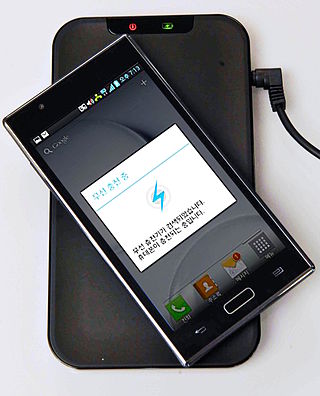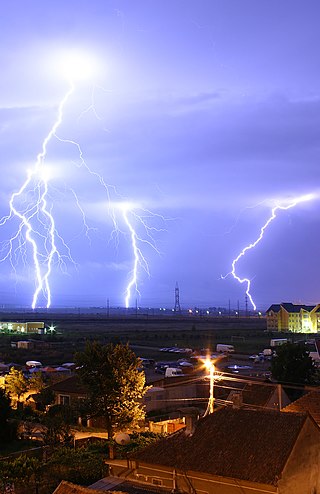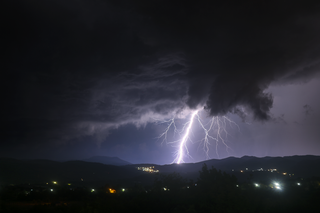Related Research Articles

Lightning is a natural phenomenon formed by electrostatic discharges through the atmosphere between two electrically charged regions, either both in the atmosphere or one in the atmosphere and one on the ground, temporarily neutralizing these in a near-instantaneous release of an average of between 200 megajoules and 7 gigajoules of energy, depending on the type. This discharge may produce a wide range of electromagnetic radiation, from heat created by the rapid movement of electrons, to brilliant flashes of visible light in the form of black-body radiation. Lightning causes thunder, a sound from the shock wave which develops as gases in the vicinity of the discharge experience a sudden increase in pressure. Lightning occurs commonly during thunderstorms as well as other types of energetic weather systems, but volcanic lightning can also occur during volcanic eruptions. Lightning is an atmospheric electrical phenomenon and contributes to the global atmospheric electrical circuit.

A fluorescent lamp, or fluorescent tube, is a low-pressure mercury-vapor gas-discharge lamp that uses fluorescence to produce visible light. An electric current in the gas excites mercury vapor, which produces short-wave ultraviolet light that then causes a phosphor coating on the inside of the lamp to glow. A fluorescent lamp converts electrical energy into useful light much more efficiently than an incandescent lamp. The typical luminous efficacy of fluorescent lighting systems is 50–100 lumens per watt, several times the efficacy of incandescent bulbs with comparable light output. For comparison, the luminous efficiency of an incandescent bulb may only be 16 lumens per watt.

A spark gap consists of an arrangement of two conducting electrodes separated by a gap usually filled with a gas such as air, designed to allow an electric spark to pass between the conductors. When the potential difference between the conductors exceeds the breakdown voltage of the gas within the gap, a spark forms, ionizing the gas and drastically reducing its electrical resistance. An electric current then flows until the path of ionized gas is broken or the current reduces below a minimum value called the "holding current". This usually happens when the voltage drops, but in some cases occurs when the heated gas rises, stretching out and then breaking the filament of ionized gas. Usually, the action of ionizing the gas is violent and disruptive, often leading to sound, light, and heat.

A surge protector (or spike suppressor, surge suppressor, surge diverter, surge protection device or transient voltage surge suppressor is an appliance or device intended to protect electrical devices in alternating current circuits from voltage spikes with very short duration measured in microseconds, which can arise from a variety of causes including lightning strikes in the vicinity.

A rectenna is a special type of receiving antenna that is used for converting electromagnetic energy into direct current (DC) electricity. They are used in wireless power transmission systems that transmit power by radio waves. A simple rectenna element consists of a dipole antenna with a diode connected across the dipole elements. The diode rectifies the AC induced in the antenna by the microwaves, to produce DC power, which powers a load connected across the diode. Schottky diodes are usually used because they have the lowest voltage drop and highest speed and therefore have the lowest power losses due to conduction and switching. Large rectennas consist of arrays of many power receiving elements such as dipole antennas.

Wireless power transfer (WPT), wireless power transmission, wireless energy transmission (WET), or electromagnetic power transfer is the transmission of electrical energy without wires as a physical link. In a wireless power transmission system, an electrically powered transmitter device generates a time-varying electromagnetic field that transmits power across space to a receiver device; the receiver device extracts power from the field and supplies it to an electrical load. The technology of wireless power transmission can eliminate the use of the wires and batteries, thereby increasing the mobility, convenience, and safety of an electronic device for all users. Wireless power transfer is useful to power electrical devices where interconnecting wires are inconvenient, hazardous, or are not possible.

A lightning arrester is a device, essentially an air gap between an electric wire and ground, used on electric power transmission and telecommunication systems to protect the insulation and conductors of the system from the damaging effects of lightning. The typical lightning arrester has a high-voltage terminal and a ground terminal. When a lightning surge travels along the power line to the arrester, the current from the surge is diverted through the arrester, in most cases to earth.

A pulse-forming network (PFN) is an electric circuit that accumulates electrical energy over a comparatively long time, and then releases the stored energy in the form of a relatively square pulse of comparatively brief duration for various pulsed power applications. In a PFN, energy storage components such as capacitors, inductors or transmission lines are charged by means of a high-voltage power source, then rapidly discharged into a load through a high-voltage switch, such as a spark gap or hydrogen thyratron. Repetition rates range from single pulses to about 104 per second. PFNs are used to produce uniform electrical pulses of short duration to power devices such as klystron or magnetron tube oscillators in radar sets, pulsed lasers, particle accelerators, flashtubes, and high-voltage utility test equipment.

High voltage electricity refers to electrical potential large enough to cause injury or damage. In certain industries, high voltage refers to voltage above a certain threshold. Equipment and conductors that carry high voltage warrant special safety requirements and procedures.
Energy harvesting (EH) – also known as power harvesting,energy scavenging, or ambient power – is the process by which energy is derived from external sources, then stored for use by small, wireless autonomous devices, like those used in wearable electronics, condition monitoring, and wireless sensor networks.
An electrolaser is a type of electroshock weapon that is also a directed-energy weapon. It uses lasers to form an electrically conductive laser-induced plasma channel (LIPC). A fraction of a second later, a powerful electric current is sent down this plasma channel and delivered to the target, thus functioning overall as a large-scale, high energy, long-distance version of the Taser electroshock gun.

Atmospheric electricity describes the electrical charges in the Earth's atmosphere. The movement of charge between the Earth's surface, the atmosphere, and the ionosphere is known as the global atmospheric electrical circuit. Atmospheric electricity is an interdisciplinary topic with a long history, involving concepts from electrostatics, atmospheric physics, meteorology and Earth science.

A lightning strike or lightning bolt is a lightning event in which the electric discharge takes place between the atmosphere and the ground. Most originate in a cumulonimbus cloud and terminate on the ground, called cloud-to-ground (CG) lightning. A less common type of strike, ground-to-cloud (GC) lightning, is upward-propagating lightning initiated from a tall grounded object and reaching into the clouds. About 25% of all lightning events worldwide are strikes between the atmosphere and earth-bound objects. Most are intracloud (IC) lightning and cloud-to-cloud (CC), where discharges only occur high in the atmosphere. Lightning strikes the average commercial aircraft at least once a year, but modern engineering and design means this is rarely a problem. The movement of aircraft through clouds can even cause lightning strikes.

A lightning detector is a device that detects lightning produced by thunderstorms. There are three primary types of detectors: ground-based systems using multiple antennas, mobile systems using a direction and a sense antenna in the same location, and space-based systems. The first such device was invented in 1894 by Alexander Stepanovich Popov. It was also the first radio receiver in the world.
In an electric power system, a fault or fault current is any abnormal electric current. For example, a short circuit is a fault in which a live wire touches a neutral or ground wire. An open-circuit fault occurs if a circuit is interrupted by a failure of a current-carrying wire or a blown fuse or circuit breaker. In three-phase systems, a fault may involve one or more phases and ground, or may occur only between phases. In a "ground fault" or "earth fault", current flows into the earth. The prospective short-circuit current of a predictable fault can be calculated for most situations. In power systems, protective devices can detect fault conditions and operate circuit breakers and other devices to limit the loss of service due to a failure.
Sprites or red sprites are large-scale electric discharges that occur in the mesosphere, high above thunderstorm clouds, or cumulonimbus, giving rise to a varied range of visual shapes flickering in the night sky. They are usually triggered by the discharges of positive lightning between an underlying thundercloud and the ground.

A lightning rod or lightning conductor is a metal rod mounted on a structure and intended to protect the structure from a lightning strike. If lightning hits the structure, it is most likely to strike the rod and be conducted to ground through a wire, rather than passing through the structure, where it could start a fire or cause electrocution. Lightning rods are also called finials, air terminals, or strike termination devices.
Electrical system design is the design of electrical systems. This can be as simple as a flashlight cell connected through two wires to a light bulb or as involved as the Space Shuttle. Electrical systems are groups of electrical components connected to carry out some operation. Often the systems are combined with other systems. They might be subsystems of larger systems and have subsystems of their own. For example, a subway rapid transit electrical system is composed of the wayside electrical power supply, wayside control system, and the electrical systems of each transit car. Each transit car’s electrical system is a subsystem of the subway system. Inside of each transit car there are also subsystems, such as the car climate control system.
An electromagnetic pulse (EMP), also referred to as a transient electromagnetic disturbance (TED), is a brief burst of electromagnetic energy. The origin of an EMP can be natural or artificial, and can occur as an electromagnetic field, as an electric field, as a magnetic field, or as a conducted electric current. The electromagnetic interference caused by an EMP can disrupt communications and damage electronic equipment. An EMP such as a lightning strike can physically damage objects such as buildings and aircraft. The management of EMP effects is a branch of electromagnetic compatibility (EMC) engineering.
A wearable generator is an article of clothing that contains some form of electrical generation system built in. The concept encompasses a variety of generation systems intended to supply small amounts of power to keep portable electronics in a good state of charge through natural motions of the body.
References
- 1 2 "Could you power a city with lightning?". physics.org. Retrieved 1 September 2011.
- ↑ Yasuhiro Shiraishi; Takahiro Otsuka (September 18, 2006). "Direct measurement of lightning current through a wind turbine generator structure". Electrical Engineering in Japan. 157 (4): 42. doi:10.1002/eej.20250. S2CID 110075189.
- ↑ "The Electrification of Thunderstorms," Earle R. Williams, Scientific American, November 1988, pp. 88–99
- 1 2 Knowledge, Dr. (October 29, 2007). "Why can't we capture lightning and convert it into usable electricity?". The Boston Globe. Retrieved August 29, 2009.
- ↑ Helman, D.S. (2011). "Catching lightning for alternative energy". Renewable Energy. 36 (5): 1311–1314. doi:10.1016/j.renene.2010.10.027.
- 1 2 Glassie, John (December 9, 2007). "Lightning Farms". The New York Times. Retrieved August 29, 2009.
- ↑ Uman Receives 2001 Fleming Medal. www.agu.org
- ↑ Discovery News Lighting Control https://www.youtube.com/watch?v=eBzxn2LEJoE
- ↑ "Teramobile".
- ↑ Jérôme Kasparian; Jean-Pierre Wolf (2010). "On Lightning Control Using Lasers". Progress in Ultrafast Intense Laser Science (PDF). Springer Series in Chemical Physics. Vol. 98. pp. 109–122. Bibcode:2010pui5.book..109K. doi:10.1007/978-3-642-03825-9_6. ISBN 978-3-642-03824-2.